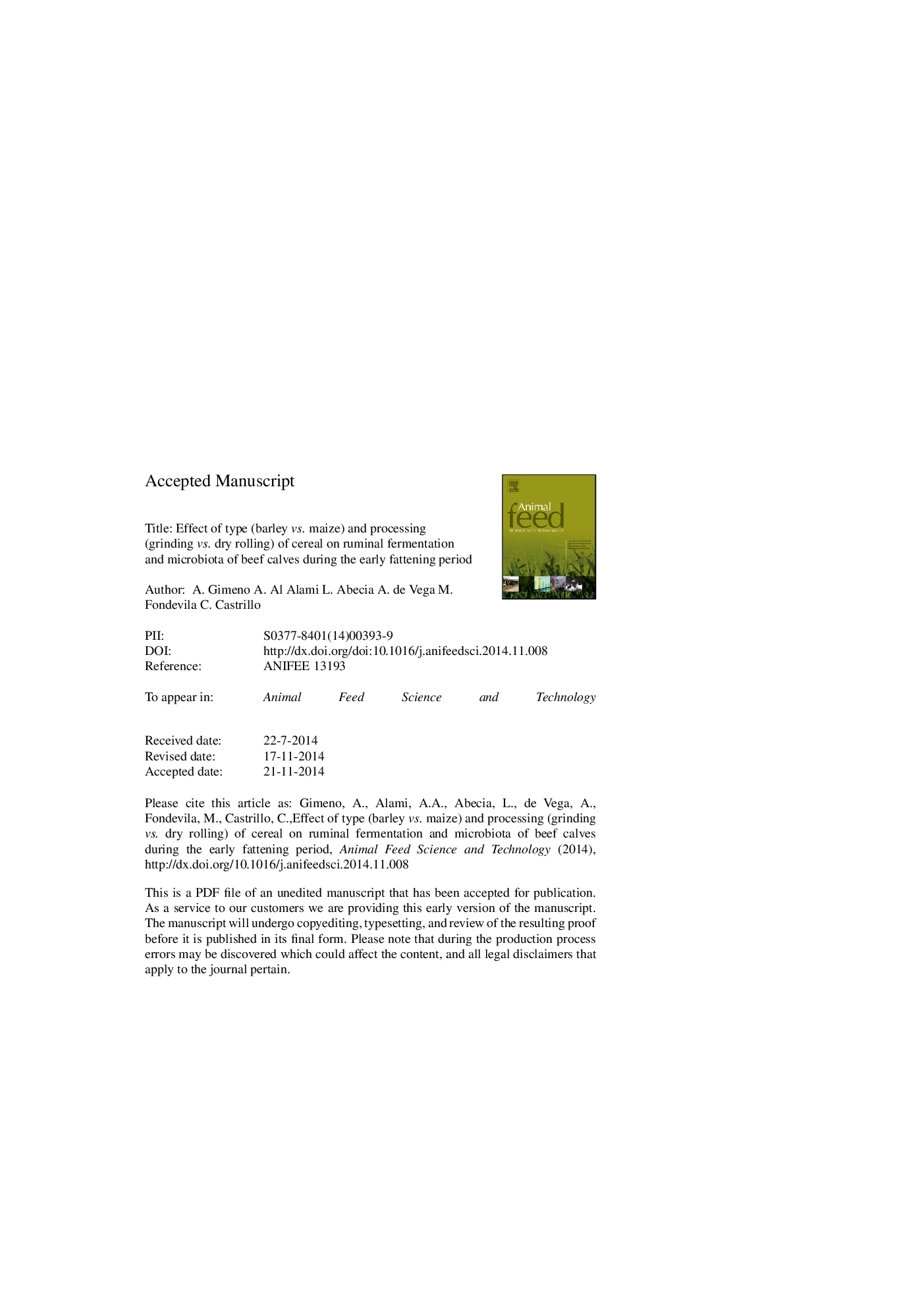| کد مقاله | کد نشریه | سال انتشار | مقاله انگلیسی | نسخه تمام متن |
|---|---|---|---|---|
| 8491442 | 1552386 | 2015 | 41 صفحه PDF | دانلود رایگان |
عنوان انگلیسی مقاله ISI
Effect of type (barley vs. maize) and processing (grinding vs. dry rolling) of cereal on ruminal fermentation and microbiota of beef calves during the early fattening period
ترجمه فارسی عنوان
اثر نوع (جو در برابر ذرت) و پردازش (سنگ زنی در مقابل غلتک خشک) غلات در تخمیر شامی و میکروبوتا گوساله های گوشت گاو در دوران دوره جوانه زدن
دانلود مقاله + سفارش ترجمه
دانلود مقاله ISI انگلیسی
رایگان برای ایرانیان
کلمات کلیدی
DMIVFARumen environmentADFomaNDFomVolatile fatty acids - اسیدهای چرب فرارAcidosis - اسیدوزacid detergent fibre expressed exclusive of residual ash - الیاف پاک کننده اسید بیانگر غلظت خاکستر باقی مانده استSARA - ساراRumen - شکمبه، سیرابیether extract - عصاره اترorganic matter - ماده آلیdry matter - ماده خشکdry matter intake - مصرف ماده خشکMicrobiota - میکروبیوتاLive weight - وزن زندهcrude protein - پروتئین خامBeef cattle - گاو گوشت گاو
موضوعات مرتبط
علوم زیستی و بیوفناوری
علوم کشاورزی و بیولوژیک
علوم دامی و جانورشناسی
چکیده انگلیسی
Ruminal acidosis is the most important nutritional disorder in intensively reared cattle and can be aggravated depending on the type of cereal in the concentrate and its processing, which affect the feed intake pattern and rumen fermentation and microbiota. Two compound feeds were formulated with a 0.60 mixture of maize and barley in proportions of 75:25 (M) and 25:75 (B), ground to 3.5Â mm (G) or dry-rolled (R). Eight 3-month old, rumen cannulated Holstein male calves were fed the experimental concentrates together with barley straw ad libitum, four of them receiving concentrate M and the other four receiving concentrate B throughout the experiment. Concentrates were offered to each animal in the two presentation forms in two 35-day periods, following a crossover arrangement. On days 33 and 35 of each period, rumen contents were sampled just before the morning feed distribution (8:30Â h) and 4 and 8Â h later to measure pH and determine volatile fatty acid (VFA), ammonia and lactic acid concentrations, as well as to characterise rumen bacterial community by qPCR. The pattern of feed intake was also monitored over the sampling days. The main cereal included in the concentrate scarcely affected ruminal fermentation. The higher fermentation rate of barley-based concentrates could be partly counterbalanced by a higher straw intake. Animals fed R cereals showed higher rumen pH (6.09 vs. 5.77, P<0.01) and lower lactic acid (72.5 vs. 95.2Â mg/L, P=0.065) and total VFA (110 vs. 138Â mmol/L, P<0.05) concentrations than those receiving G. This effect was in general more evident when maize was the major cereal in the concentrate, although the interaction of cereal type by processing form was not significant. Scarce effects on rumen microbiota were promoted by dietary factors; however, the low ruminal proportion of Streptococcus bovis observed regardless of the diet fed and rumen pH suggests that other microorganisms could be involved in the appearance of acidosis in beef cattle on high-grain diets. The more buffered rumen fermentation associated with dry-rolling processing could be partly due to its higher particle size, which reduces microbial and enzymatic access to the starch and its fermentation rate, at the same time as it promotes a more homogeneous pattern of intake throughout the day. Therefore, this processing method could be useful for preventing acidosis in beef calves at the outset of the fattening stage, especially when feeding maize-based diets.
ناشر
Database: Elsevier - ScienceDirect (ساینس دایرکت)
Journal: Animal Feed Science and Technology - Volume 199, January 2015, Pages 113-126
Journal: Animal Feed Science and Technology - Volume 199, January 2015, Pages 113-126
نویسندگان
A. Gimeno, A. Al Alami, L. Abecia, A. de Vega, M. Fondevila, C. Castrillo,
